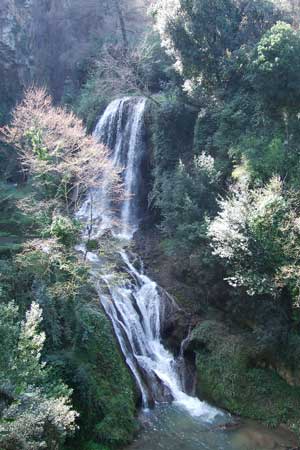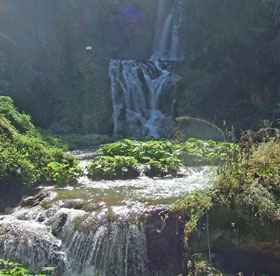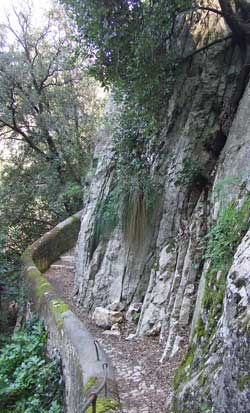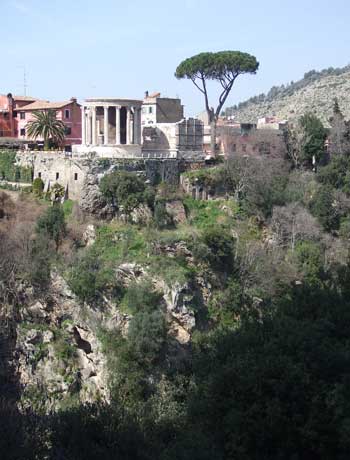Tivoli is known for three impressive ‘villas,’ of which the Villa Gregoriana is the least well-known. The more famous pair are the Villa d’Este, famous for its fountains, and the Villa Adriana, the sprawling ruins of the Emperor Hadrian’s massive palace complex in the countryside nearby. Each has its own very different character, and the Villa Gregoriana is remarkable not for archaeology or for hydraulics (though both are represented here) but for its natural splendours. The Villa is basically a dramatic wooded ravine where visitors follow footpaths past waterfalls, caves and ruins. A panoramic bridge, the Ponte Gregoriano, crosses the valley by the Villa.

History
Tivoli was a popular residential and resort town for the ancient Romans, who constructed two temples on the brink of a steep valley alongside the hilltown. A river called the Aniene plunges down cliffs and along the ravine. The waterfalls and caves here were important and sacred spots. At the valley bottom there was a lake, until a great and destructive flood in 105AD – described by Pliny the Younger – resulted in the waters forcing a way down into the ground and through tunnels to the plains below. Today you can see water-smoothed rocks by the path where the river used to flow, and peer down into the dark cave system where the waters now vanish.
After a destructive flood in the 1820s the popes took a hand. Under Pope Gregory XVI, engineers diverted the main flow of the river through two new man-made flood tunnels which channeled the water away from town. These tunnels send the water down cliffs opposite town, creating a vast new waterfall. Visitors came to Tivoli to admire the engineering and the dramatic scenery of the new public park, named the Villa Gregoriana after Pope Gregory. Tivoli was a popular destination for travellers making their Grand Tour of Europe. The view over the valley incorporating temple and waterfall has been said to be one of the most-painted landscapes in the world.
At the beginning of the twenty-first century the Italian conservation organisation FAI began restoring the overgrown and abandoned site, re-established footpaths and opened the Villa Gregoriana to the public. The FAI is Italy’s version of the National Trust and it is affiliated with the UK organisation: National Trust members can visit FAI properties, including the Villa Gregoriana, free of charge if they bring their membership cards.
About the Villa Gregoriana today

There are two entrances to the Villa Gregoriana, one on either side of the ravine. The principal path through the site winds downhill then up again, from one entrance to the other. There are several alternative routes branching off the path leading to viewpoints and sights. The most awe-inspiring view is from a viewpoint by the Great Cascade (Grande Cascata), accessed by a narrow path with lots of steps. It’s worth the effort to get there, for the impressive view up and down the waterfall, as rainbows form in the spray. It is also possible to reach the top of the waterfall, where the water issues from the two tunnels in the cliffs.
Down at the foot of the hillside you’ll find yourself in the marvellously-named Valley of Hell (Valle dell’Inferno). The river rushes into the Sirens’ Cave (Grotta delle Sirene), a really epic sight, where water leaps and races down into darkness. Other sights include the ruins of a Roman villa, two Roman chambers cut in the rock with valley views, and a Napoleonic-era tunnel.

Practicalities and advice
The Ingresso dei Templi (Temples Entrance) is by the Tivoli temples, along Via Sibilla. Here there is a shop and a cafe serving light lunches. The other entrance, Ingresso delle Cascate, is on the far side of the gorge, over the Ponte Gregoriano. There are toilets inside the grounds close to each entrance, and there is a car park near the Waterfalls (Cascate) entrance.
Admission to the Villa Gregoriana costs 5 (free for National Trust members). The site is included in combined tickets organised by the Provincia di Roma. Opening hours vary according to the season, so check on the FAI website before you travel. Between December and February the site is only open by appointment. It is closed on Mondays, unless they are public holidays.
The paths are roughly surfaced and occasionally muddy. There are many steps and slopes, with a lot of height to lose and gain as you cross the narrow valley. You will need sensible shoes, and I wouldn’t recommend this outing for the unfit. There are, however, plenty of benches where you can sit and rest or enjoy the views. Since the area is shady, I’d advise bringing insect repellent on summer or autumn excursions. You should allow at least an hour and a half for the visit. You can get a good lunch nearby at the restaurant by the temples, or at the cafeteria. I found a useful takeaway shop by the bridge, selling a huge range of filled piadine and cold drinks, with benches to sit on.
To get to the villa by public transport, take the bus or the train to Tivoli and then walk (see Tivoli tourist information for more travel advice). It helps to have a map of Tivoli, as the town isn’t well signposted – collect one from the tourist information office or bring your own guidebook or printout. From the town’s main bus stop on Largo Garibaldi it’s about a ten-minute walk along a narrow shopping street, through the central Piazza Plebiscito, then downhill along more lanes to the bridge overlooking the Villa Gregoriana.
Villa Gregoriana is less touristy than Tivoli’s other two villas, and walking there gives you a nice tour of the town itself. However, you couldn’t comfortably fit all three villas into one day trip – it may be possible, but it would be a very rushed day. If they all interest you, and you fancy a break from Rome, I’d suggest spending a night or two in the Tivoli area, or even making the trip out of town twice to enjoy the calmer provincial atmosphere and to visit the villas with more leisure.
> Tivoli travel and tourist information
On this site
Useful external links
FAI – Fondo per l’Ambiente Italiano
Lazio destinations
- About the Lazio region
- Anzio
- Bracciano
- Calcata
- Castel Gandolfo
- Castelli Romani
- Cerveteri
- Formia
- Frascati
- Gaeta
- Palestrina
- Pontine islands
- Ponza
- Rome
- Sperlonga
- Terracina
- Tivoli
- Ventotene
- Viterbo
